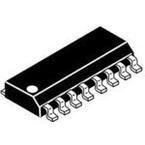herunterladen

© Semiconductor Components Industries, LLC, 2011
November, 2011 − Rev. 1
1 Publication Order Number:
AND8147/D
AND8147/D
An Innovative Approach to
Achieving Single Stage PFC
and Step-Down Conversion
for Distributive Systems
INTRODUCTION
In most modern PFC circuits, to lower the input current
harmonics and improve the input power factor, designers
have historically used a boost topology. The boost topology
can operate in the Continuous Conduction Mode (CCM),
Discontinuous Conduction Mode (DCM), or Critical
Conduction Mode.
Most PFC applications using the boost topology are
designed to operate over the universal input AC voltage
range (85−265 Vac), at 50 or 60 Hz, and provide a regulated
DC bus (typically 400 Vdc). In most applications, the load
can not operate from the high voltage DC bus, so a DC−DC
converter is used to provide isolation between the AC source
and load, and provide a low voltage output. The advantages
to this system configuration are low Total Harmonic
Distortion (THD), a power factor close to unity, excellent
voltage regulation, and fast transient response on the
isolated DC output. The major disadvantage of the boost
topology is that two power stages are required which lowers
the systems efficiency, increases component count, cost, and
increases the size of the power supply.
ON Semiconductor’s NCP1651 (www.onsemi.com)
offers a unique alternative for Power Factor Correction
designs, where the NCP1651 has been designed to control
a PFC circuit operating in a flyback topology. There are
several major advantages to using the flyback topology.
First, the user can create a low voltage isolated secondary
output, with a single power stage, and still achieve a low
input current distortion, and a power factor close to unity. A
second advantage, compared to the boost topology with a
DC−DC converter, is a lower component count which
reduces the size and the cost of the power supply.
Traditionally, the flyback approach has been ignored for
PFC applications because of the perceived limitations such
as high peak currents and high switch voltage ratings. This
paper will demonstrate the novel control approach
incorporated in the NCP1651 design, coupled with advances
in discrete semiconductor technology that have made the
flyback approach very feasible for a range of applications.
Controller Analysis
The NCP1651 can operate in either the Continuous or
Discontinuous mode of operation. The following analysis
will help to highlight the advantages of Continuous versus
Discontinuous mode of operation.
The table below defines a set of conditions from which the
comparison will be made between the two modes of
operation.
Table 1.
Po = 90 W
Vin = 85−265 Vrms (analyzed at 85 Vrms input)
Efficiency = 80%
Pin = 108 W
Vo = 48 Vdc
Freq = 100 kHz
Transformer turns ratio n = 4
Continuous Mode (CCM)
To force the inductor current to be continuous over the
majority of the input voltage range (85−265 Vac) the
primary inductance, Lp needs to be at least 1.0 mH. Figure 1
shows the typical current through the primary winding of the
flyback transformer. During the switch on period, this
current flows in the primary and during the switch off−time,
it flows in the secondary.
TIME
I
pk
I
avg
Figure 1.
Therefore, the peak current can be calculated as follows:
I
pk
+ I
avg
)
(1.414 · V
in
sin q ·t
on
·2)
L
p
(eq. 1)
http://onsemi.com
APPLICATION NOTE
Verzeichnis








